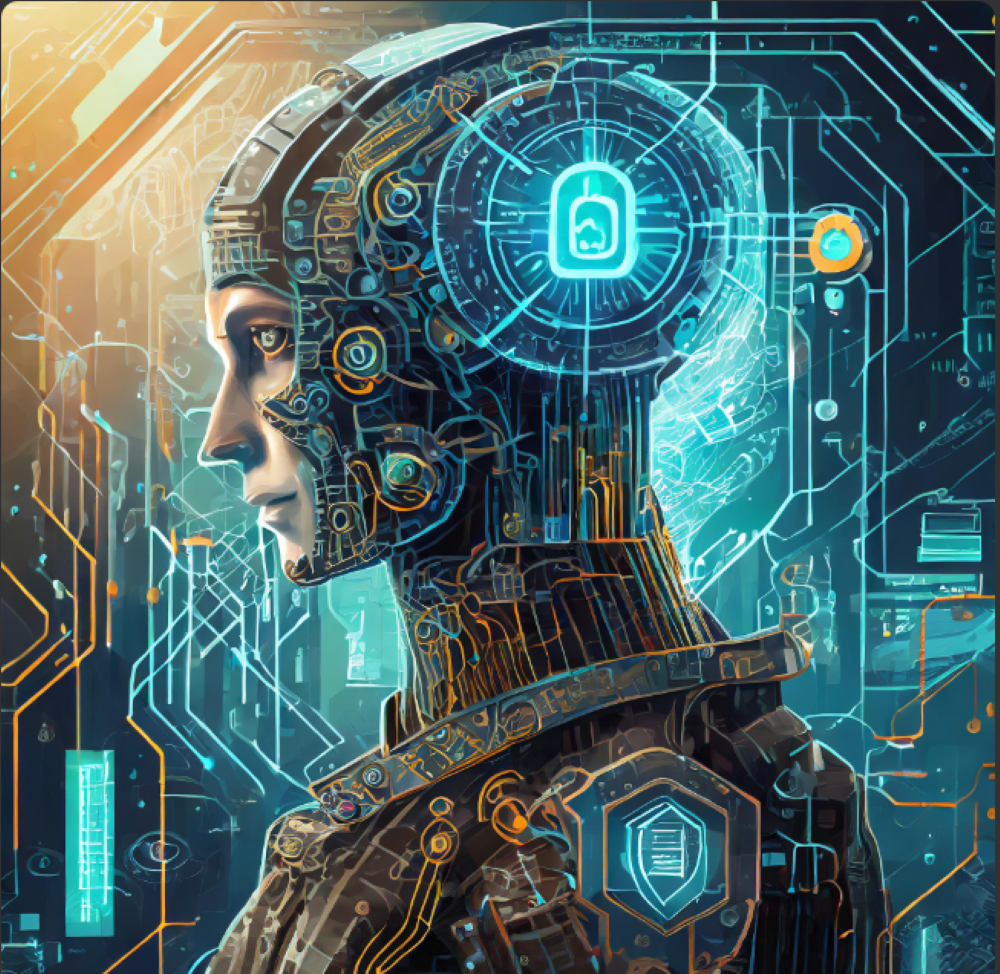THE ROLE OF ARTIFICIAL INTELLIGENCE IN ENHANCED CYBERSECURITY
Cybersecurity risks are present everywhere. Artificial intelligence revolutionizes cybersecurity by extending human capabilities. Here, we discuss how AI has altered cybersecurity.

INTRODUCTION
When artificial intelligence is used, a human can make decisions thanks to the brain and through speech recognition analysis of visual elements or language translation. With the use of training data, AIs learn context and can decide on fitting actions or reactions for specific situations.
Cybersecurity risks are present everywhere. The attackers use sophisticated software and intricate algorithms that keep coming up with new strategies all the time, so the solution is easy to figure out. The introduction of cyberattacks deprives traditional security measures of their source of power. AI revolutionizes cyber security by extending human capabilities and solving more sophisticated hacking problems. It has transcended science fiction. Intelligent solutions can be trained to prevent the leakage of confidential corporate data, detect new variants based on malware, initiate alarm signals, and perform cyber threat autonomic discovery.
In the following paper, however, we will discuss how AI has altered our digital society in terms of its use and advantages as well as disadvantages.
Applications of artificial intelligence in cyber security
- Threat Detection and Prevention:
Real-time threat detection and prevention is one of the main functions that AI fulfills in cyber security. Machine learning models use huge quantities of data to reveal patterns and outliers that suggest malicious intent. The introduction of anomaly detection systems and predictive analytics enables the development of preemptive responses, thus preventing hacking before it is committed. Such an approach precludes organizations from falling victim to preventable attacks.
2. Password protection and authentication:
Organizations are secured with the passwords and authentication of user accounts by artificial intelligence. The bigger sites have login features for product purchases or contact forms to reveal their private information. Malicious actors require additional layers of security measures to ensure the protection of their data.
Within businesses, AI capabilities like facial recognition signatures and CAPTCHA can be employed in automatic authentication analysis. They work towards curtailing cyber-crime strategies such as credential stuffing and brute-force attacks.
3. Network security:
This includes the intricate process of policy-making and network topology understanding. After putting the policies into practice, organizations can develop mechanisms to differentiate connections that might be considered safe from those requiring examination due to questionable activity. However, it is time-consuming to create rules for various networks and consumes lots of people’s efforts. Eventually, AI will detect certain patterns in the network traffic of an organization and assign appropriate policies as well as workloads.
4. Behavioral Analysis:
AI-powered systems are very effective when it comes to behavioral analysis as they analyze the network and user patterns, looking for anomalies. Through AI, the system manufactures a template of baseline behavior to enable the identification of abnormal activities that may signal an intrusion attempt. This flexible approach is essential in situations where signature-based methods would fail to detect undiscovered threats, including zero-day attacks.
5. Predictive Analysis:
Artificial intelligence can give cyber security professionals the ability to predict potential mistakes and vulnerabilities within a system. If historical data and current trends are assessed, AI models can enable possible cyberattacks to be predictable. It makes it possible for businesses to prevent vulnerabilities from being exploited against them.
6. Automated Response and Mitigation:
Quick retaliation is required in the cyber security world that moves so fast. Automation of reaction times to security concerns offered by AI is faster. Automated responses by AI reduce threat response times. Automated mitigation actions can consequently be implemented according to predetermined policies, reducing the effects that an active assault may have and minimizing potential damages.
7. Enhanced Phishing Detection:
Phishing attacks are common and primarily use human weaknesses. Analyses by AI models trained using billions of phishing emails and malware samples can detect even the most sophisticated impersonation attempts as well as zero-day threats. AI-powered solutions based on machine learning and natural language processing detect phishing attacks before they cause harm to end users. The use of AI in email security has enabled businesses to spot anomalies and warn of signs related to malicious messages.
8. Threat Intelligence:
AI allows for faster data processing and analysis regarding threats. Cybersecurity professionals can receive timely updates and insights from platforms equipped with AI technology while monitoring the global threat landscape. Therefore, companies can continue to respond to emerging threats and change their defensive strategies accordingly.
9. Vulnerability Management:
Due to the use of innovative hacking methods and approaches, thousands of new vulnerabilities are identified per year. Due to this, companies struggle with processing the frightening number of new vulnerabilities they find every day, and old-fashioned systems fail to stop such high-risk attacks on time.
AI-driven vulnerability scanners scan systems for flaws and assign high priority to serious weaknesses before their exploitation by attackers. Without human error, this automation dramatically reduces the time required to rectify security vulnerabilities.
10. Adaptive Security:
Because the nature of cyber threats is dynamic, traditional security solutions often struggle to adapt. Cybersecurity borrows a flexible nature from the constant learning and development of AI. This flexibility allows security systems to effectively address new and complex attack vectors.
11. Adaptive Security:
Traditional security procedures can barely keep pace with the rapid evolution of cyber threats. The adaptive nature of cyber security is supported by AI because it learns every day. This flexibility of security systems ensures their responsiveness whenever new and more innovative attack vectors emerge.
Benefits of artificial intelligence in managing cyber threats
Currently, cyber security improvements need human intervention. However, AI may automatize some operations, such as system surveillance. This will enable the company to gather more threat intelligence and find new risks faster. Among the advantages are:
- Enhanced Scalability and Efficiency:
Automation of routine tasks frees human security analysts, enabling them to concentrate on important goals. This enables the teams to respond more methodically to an increased horizon of threats, even when there is an increase in surface area.
2. Quicker Threat Detection and Response:
With increasingly sophisticated attack vectors deployed by hackers, organizations get into unnoticed threats that can cause a lot of damage to networks. The ability of AI to analyze and detect risks in an instant reveals its capacity for speed. This timely response decreases the attacker’s dwell time, thus minimizing potential harm and simplifying incident management.
3. Better Security Posture and Accuracy:
In this case, AI algorithms are self-learning and flexible; hence, they perform better at identifying even the most sophisticated reemerging threats. Such uninterrupted development guarantees that the security posture remains in a constant state of mutability, which can prevent various hacker strategies.
4. Cost-efficiency:
With the integration of cyber security and AI, faster data acquisition is made possible. Thus, the incident management response becomes more streamlined and dynamic. Most importantly, it frees security professionals from the burden of performing mundane manual operations that are time-consuming and have no strategic value for a company.
5. Eliminating human mistakes:
One of the flaws that is always associated with conventional security systems is manned operations arising from human error, which can be very expensive. Most procedures that fall within the realm of cyber security have human intervention removed by artificial intelligence. This method is also more productive because the human resources can be moved to areas where their use will produce better outcomes.
6. Massive data quantities:
In contrast with security professionals, AI systems can perform high-order data processing and interpretation. However, by doing so, organizations can identify new risks from the data mountains and network traffic that are not detected through traditional KPIs.
Challenges of artificial intelligence in cyber security
Even if AI has a great deal of potential to improve cyber security, it also poses important questions:
- Bias and Explainability: Unfair security systems and discriminatory practices face the threat of biased AI algorithms that are well-oiled through biased data. To help prevent social injustices from being perpetuated, AI-enabled security systems should involve transparency and readability.
- Adversarial strikes: Adversaries may exploit AI models in malicious ways to remain undetected or carry out sophisticated attacks. It is also essential to perform comprehensive simulation attacks along with continuous vulnerability assessments to guarantee the effectiveness of AI-powered defenses.
- Privacy Issues: However, effective AI implies the need for large-scale data collection and processing. However, this creates questions about the protection of personal user data and its potential misuse. In cyber security, ethical AI could be used to achieve an optimal balance between privacy and security.
The Future of AI in Cybersecurity
Although AI is not a cure-all, it boasts tremendous power that, when employed rationally and ethically, could significantly bolster our cyber security. For creating a strong and agile system security ecosystem, human assistance will be crucial for the future of cyber security. Therefore, new functionalities stemming from cutting-edge AI concepts and strategies are critical to detecting the latest threats quickly before hackers exploit emerging vulnerabilities due to how fast they learn as opposed to human countermeasures. We achieve this by investing considerately in R&D and tackling technical as well as ethical enigmas consistently.
CONCLUSION
Cyber threats should change, and artificial intelligence must be incorporated into cyber security. Through its predictive capacity for real-time threat detection and analysis, artificial intelligence helps to strengthen cyber security's overall posture. AI helps organizations enhance security and stay two steps ahead of cyber threats in today’s ever-changing digital world.
Thanks for reading.
If you like the article, consider sharing and subscribing. ;)





